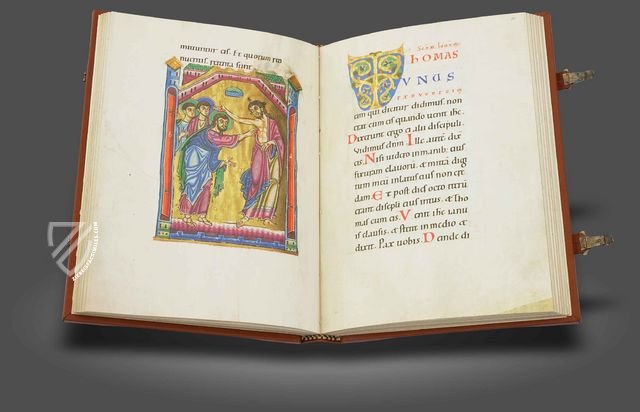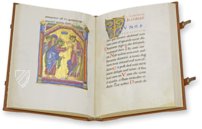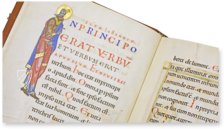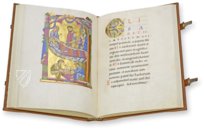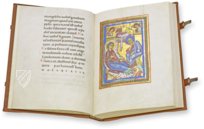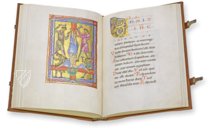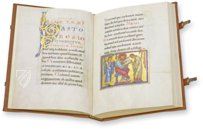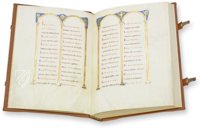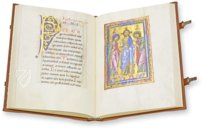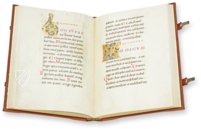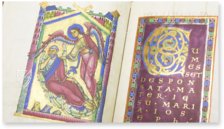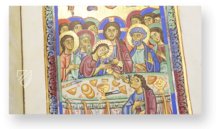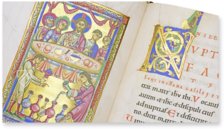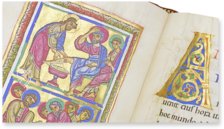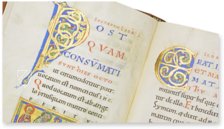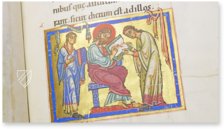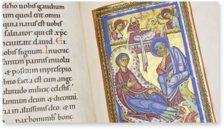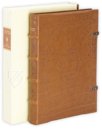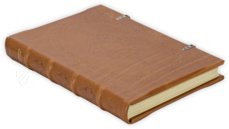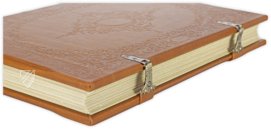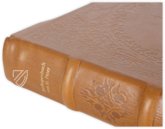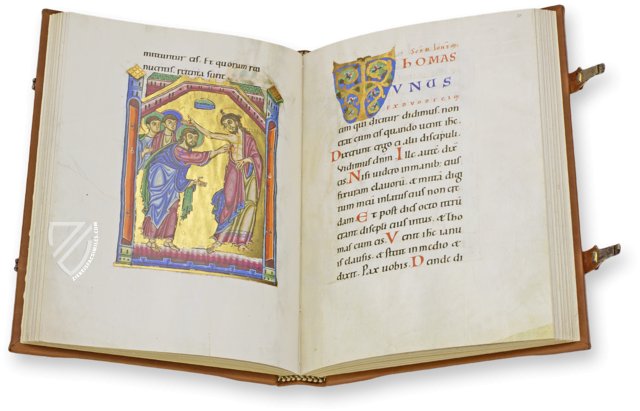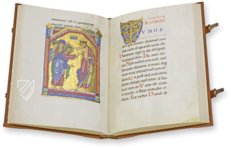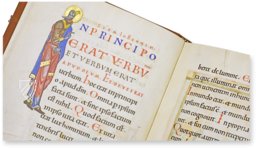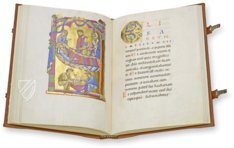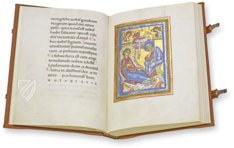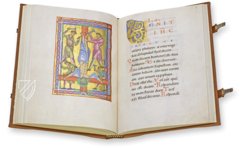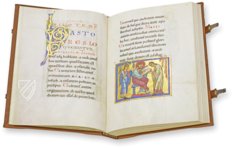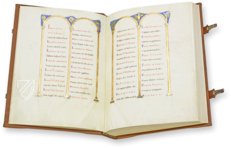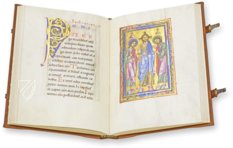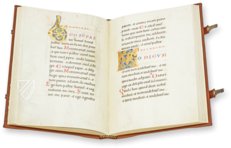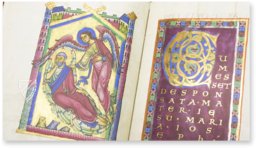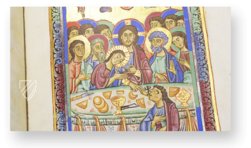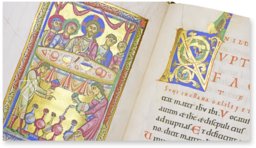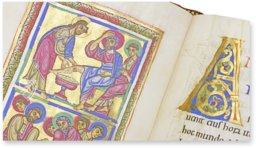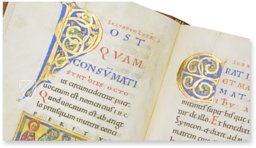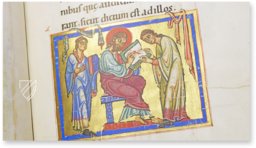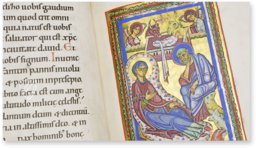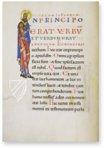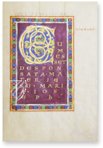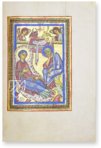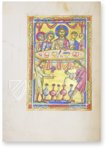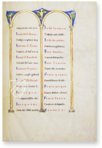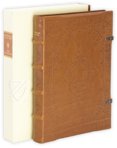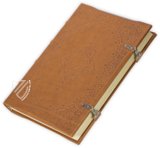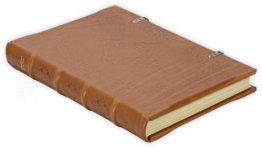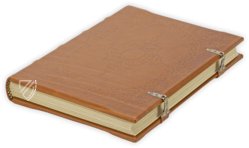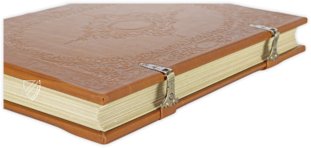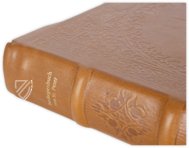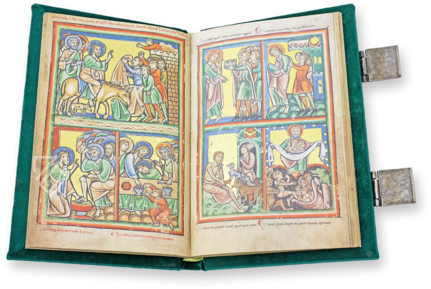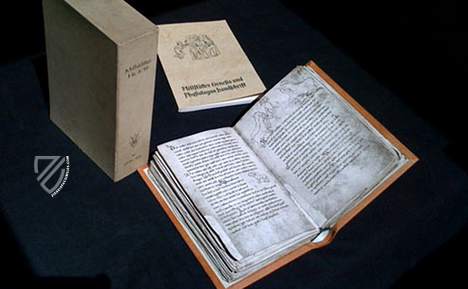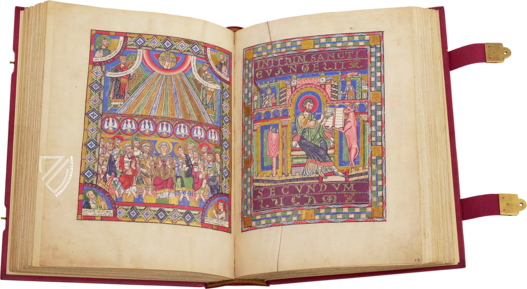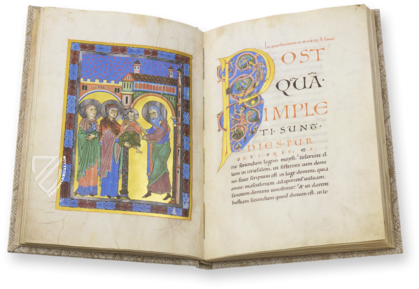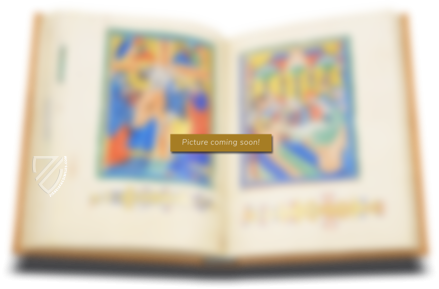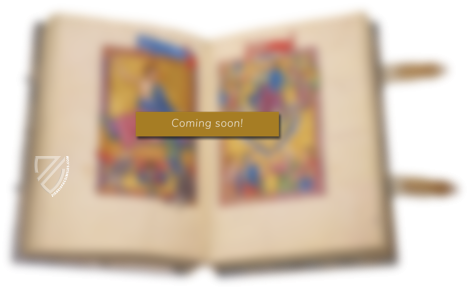St. Peter Pericopes from St. Erentrud
(3,000€ - 7,000€)
The St. Peter Pericopes from St. Erentrud are adorned with 55 gorgeously colored miniatures with radiant gold backgrounds and 81 golden initials with scroll ornament, making it the most richly illuminated surviving Gospel manuscript from the High Middle Ages. Created in the middle of the 12th century, a wonderful and unparalleled picture program on the life and work of Christ unfolds on its 106 pages. The readings for the high feasts such as Christmas, Easter or the feasts of Mary and the saints are often suitably introduced by opulent full-page miniatures in magnificent framings. The elaborate images are characterized by a combination of Byzantine stylistic principles and Western iconography, which reveals a close relationship to older works from the scriptorium of St. Peter in Salzburg, which is where the manuscript was probably also created. Undoubtedly, the scribes and illuminators involved were masters of their trade and produced a highlight of Romanesque book art.
St. Peter Pericopes from St. Erentrud
55 colorful miniatures on a gold background – and the richest image program of a high medieval evangeliary manuscript to boot – as well as 81 mostly anthropomorphic gold initials with bright flowers and tendrils: so reads the fact sheet of the mid–12th century St. Peter Pericopes, which is stored under the shelf mark Clm 15903 in the Bavarian State Library in Munich. A pictorial and decorative program that is both quantitatively and qualitatively the peer of any other reveals itself to the beholder across 106 folios of the St. Peter Pericopes. Of the miniatures that are arranged before the readings for the Christmas and Easter cycles, the miracles and resurrection of Christ, and the feast days for the Virgin Mary and saints, as well as the Feast of the Finding and Veneration of the Cross, well over half are full-page. Broad, rectangular frames with ornamented fillings between strips of gold and silver trim the biblical scenes like panel paintings. Precious gold leaf makes up the backgrounds of these large-figured scenes, which are executed in powerful, off-color opaque paints. Individual architectural elements and indications of landscapes help to locate the events. Dignified figures dominate the symmetrical image composition. Lifelike mimicry and glances with big eyes connect them with one another and thus simultaneously convey the content of the image and its emotional expression. The close relationship of our manuscript to the older works from the scriptorium of St. Peter is manifest in the connection of Byzantine principles of style with visual themes from western examples and the practice of plastically modelling the bodies of the figures with the help of color shading.
A World in Initials
Another way that the St. Peter Pericopes distinguishes itself is with its fantastical initial embellishment. An initial stands at the beginning of each pericope – either as an individual letter, or often as a part of a group of initials forming a connection between both of the initial letters and the actual text of the pericope. The gilded corpus of each letter is wrapped with vines, whose offshoots end in bright buds and blooms. Individual parts of the letters are replaced in countless variations by living creatures – mostly animals – that lend the manuscript a sanguine note.
Eu Angelion – the Good News in Word and Image
Pericope books contain every selection (pericope) from the Gospels that is chosen as a reading for the individual Sundays and feast days of the liturgical year. Of the 71 pericopes in this manuscript, no less than 55 are introduced by miniatures. Their function is not limited to illustrating the relevant text, instead they visually reiterate it. What is more, the narrative horizon is additionally broadened and interpreted with the help of iconographic devices. An example thereof is the miniature of Jesus among the scholars, in which the 12 year old boy is depicted as a grown, bearded man. This device helps to overcome the time continuum as well as foreshadowing the role of Christ as the Messiah. Such surprising pictorial solutions appear throughout the entire manuscript. They serve the overall textual concept, in which Christ is presented as the Annointed, the Savior – the Messiah.
A Romanesque Masterpiece Formerly in the Collection of St. Erentrud in Salzburg
Widely referred to in scholarly literature by the name Book of Pericopes from St. Erentrud, the codex’s name comes from the Benedictine convent on Salzburg’s Nonnberg. A note from the late 13th or early 14th century on folio 104v in the manuscript verifies that the codex belonged to the convent’s collection by that time at the latest. Yet, St. Erentrud is neither the place of origin nor the destination of the pericope book. The Salzburgian provenance of the manuscript is uncontested. Not only is this indicated by the content, such as repeated references to St. Rupert, who not only founded the bishopric of Salzburg and was its first bishop, but is also venerated as the founder of the Benedictine monasteries of St. Peter and St. Erentrud. The close artistic affinity to codices originating undoubtedly from Salzburg indicates that the pericope book came from a local scriptorium. Of the three scriptoria that were active in Salzburg in the mid–12th century (the cathedral scriptorium, the scriptorium of the Petersfrauen, and that of St. Peter), only one can be considered the place of origin for reasons of style, iconography, and content – the scriptorium of St. Peter.
Codicology
- Alternative Titles
- Perikopenbuch von St. Peter
Perikopenbuch aus St. Erentrud in Salzburg
Evangelia in missa legi solita, praecedente capitulari evangeliorum - Size / Format
- 212 pages / 31.0 × 22.0 cm
- Origin
- Austria
- Date
- Around 1150
- Epochs
- Style
- Language
- Script
- Rounded, large-sized minuscule script
- Illustrations
- 55 miniatures (33 of which are full-page), 6 decorated pages with an index of the 71 pericopes, 1 initial page and 81 figural and vine initials, executed in opaque color painting and silver on a gold ground
- Previous Owners
- Benedictine convent of Saint Erentrud (Nonnberg)
St. Peter Pericopes from St. Erentrud
Circumcision of Jesus
As told in the Gospel of Luke, Jesus was circumcised eight days after his birth in accordance with Jewish law. The figures in this scene display the rediscovered naturalism of Romanesque art, although the Rabbi’s scalpel is alarmingly large. This small glimmering masterpiece is one of the few standalone depictions of the Circumcision to predate the Renaissance and is obviously influenced by Byzantine art as evidenced by its burnished gold background and strongly-gesturing figures.
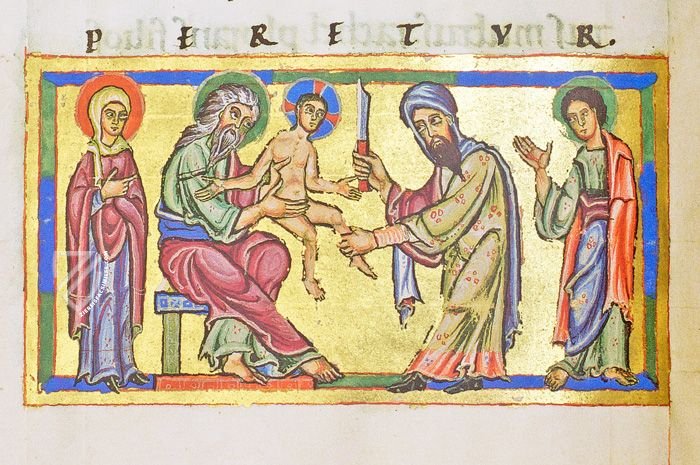
St. Peter Pericopes from St. Erentrud
Baptism of Jesus
This miniature exhibits strong Byzantine artistic influences and is a splendid sample of arguably the most extensively illuminated Gospel book of the Middle Ages. It and other miniatures in this manuscript are clearly modelled on Byzantine originals from previous decades, indicating a certain knowledge of Byzantine art that was possibly acquired in the course of the Second Crusade.
Christ is depicted almost fully submerged, John the Baptist has his hand on Jesus’ head in the moment that the Holy Spirit descends upon him in the form of a dove. An angel, with wings extending beyond the image and into the frame, appears as though it has just flown down from heaven to hand Jesus a towel. The burnished gold leaf background of the image gives it a timeless and spaceless feeling.
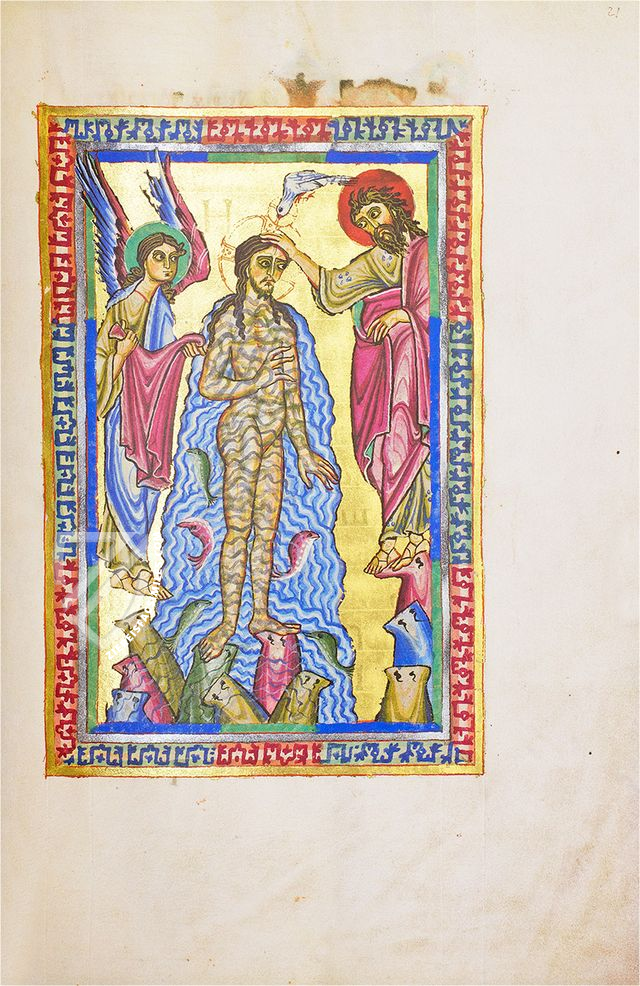
#1 Das Perikopenbuch von St. Peter
Languages: English, German
The commentary to the facsimile edition was authored by Martina Pippal, Austria’s most expert specialist in Romanesque manuscript art. In addition to an in-depth art historic analysis, the author mainly focuses on the relationship between pictures and text and on the environment in which the book was made, both in terms of history and the history of ideas.
(3,000€ - 7,000€)
- Treatises / Secular Books
- Apocalypses / Beatus
- Astronomy / Astrology
- Bestiaries
- Bibles / Gospels
- Chronicles / History / Law
- Geography / Maps
- Saints' Lives
- Islam / Oriental
- Judaism / Hebrew
- Single Leaf Collections
- Leonardo da Vinci
- Literature / Poetry
- Liturgical Manuscripts
- Medicine / Botany / Alchemy
- Music
- Mythology / Prophecies
- Psalters
- Other Religious Books
- Games / Hunting
- Private Devotion Books
- Other Genres
- Afghanistan
- Armenia
- Austria
- Belgium
- Belize
- Bosnia and Herzegovina
- China
- Colombia
- Costa Rica
- Croatia
- Cyprus
- Czech Republic
- Denmark
- Egypt
- El Salvador
- Ethiopia
- France
- Germany
- Greece
- Guatemala
- Honduras
- Hungary
- India
- Iran
- Iraq
- Israel
- Italy
- Japan
- Jordan
- Kazakhstan
- Kyrgyzstan
- Lebanon
- Liechtenstein
- Luxembourg
- Mexico
- Morocco
- Netherlands
- Palestine
- Panama
- Peru
- Poland
- Portugal
- Romania
- Russia
- Serbia
- Spain
- Sri Lanka
- Sweden
- Switzerland
- Syria
- Tajikistan
- Turkey
- Turkmenistan
- Ukraine
- United Kingdom
- United States
- Uzbekistan
- Vatican City
- A. Oosthoek, van Holkema & Warendorf
- Aboca Museum
- Ajuntament de Valencia
- Akademie Verlag
- Akademische Druck- u. Verlagsanstalt (ADEVA)
- Aldo Ausilio Editore - Bottega d’Erasmo
- Alecto Historical Editions
- Alkuin Verlag
- Almqvist & Wiksell
- Amilcare Pizzi
- Andreas & Andreas Verlagsbuchhandlung
- Archa 90
- Archiv Verlag
- Archivi Edizioni
- Arnold Verlag
- ARS
- Ars Magna
- ArtCodex
- AyN Ediciones
- Azimuth Editions
- Badenia Verlag
- Bärenreiter-Verlag
- Belser Verlag
- Belser Verlag / WK Wertkontor
- Benziger Verlag
- Bernardinum Wydawnictwo
- BiblioGemma
- Biblioteca Apostolica Vaticana (Vaticanstadt, Vaticanstadt)
- Bibliotheca Palatina Faksimile Verlag
- Bibliotheca Rara
- Boydell & Brewer
- Bramante Edizioni
- Bredius Genootschap
- Brepols Publishers
- British Library
- C. Weckesser
- Caixa Catalunya
- Canesi
- CAPSA, Ars Scriptoria
- Caratzas Brothers, Publishers
- Carus Verlag
- Casamassima Libri
- Centrum Cartographie Verlag GmbH
- Chavane Verlag
- Christian Brandstätter Verlag
- Circulo Cientifico
- Club Bibliófilo Versol
- Club du Livre
- CM Editores
- Collegium Graphicum
- Collezione Apocrifa Da Vinci
- Comissão Nacional para as Comemorações dos Descobrimentos Portugueses
- Coron Verlag
- Corvina
- CTHS
- D. S. Brewer
- Damon
- De Agostini/UTET
- De Nederlandsche Boekhandel
- De Schutter
- Deuschle & Stemmle
- Deutscher Verlag für Kunstwissenschaft
- DIAMM
- Droz
- E. Schreiber Graphische Kunstanstalten
- Ediciones Boreal
- Ediciones Grial
- Ediclube
- Edições Inapa
- Edilan
- Editalia
- Edition Deuschle
- Edition Georg Popp
- Edition Leipzig
- Edition Libri Illustri
- Editiones Reales Sitios S. L.
- Éditions de l'Oiseau Lyre
- Editions Medicina Rara
- Editorial Casariego
- Editorial Mintzoa
- Editrice Antenore
- Editrice Velar
- Edizioni Edison
- Egeria, S.L.
- Eikon Editores
- Electa
- Emery Walker Limited
- Enciclopèdia Catalana
- Eos-Verlag
- Ephesus Publishing
- Ernst Battenberg
- Eugrammia Press
- Extraordinary Editions
- Fackelverlag
- Facsimila Art & Edition
- Facsimile Editions Ltd.
- Facsimilia Art & Edition Ebert KG
- Faksimile Verlag
- Feuermann Verlag
- Folger Shakespeare Library
- Franco Cosimo Panini Editore
- Friedrich Wittig Verlag
- Fundación Hullera Vasco-Leonesa
- G. Braziller
- Gabriele Mazzotta Editore
- Gebr. Mann Verlag
- Gesellschaft für graphische Industrie
- Getty Research Institute
- Giovanni Domenico de Rossi
- Giunti Editore
- Graffiti
- Grafica European Center of Fine Arts
- Guido Pressler
- Guillermo Blazquez
- Gustav Kiepenheuer
- H. N. Abrams
- Harrassowitz
- Harvard University Press
- Helikon
- Hendrickson Publishers
- Henning Oppermann
- Herder Verlag
- Hes & De Graaf Publishers
- Hoepli
- Holbein-Verlag
- Houghton Library
- Hugo Schmidt Verlag
- Idion Verlag
- Il Bulino, edizioni d'arte
- ILte
- Imago
- Insel Verlag
- Insel-Verlag Anton Kippenberger
- Instituto de Estudios Altoaragoneses
- Instituto Nacional de Antropología e Historia
- Introligatornia Budnik Jerzy
- Istituto dell'Enciclopedia Italiana - Treccani
- Istituto Ellenico di Studi Bizantini e Postbizantini
- Istituto Geografico De Agostini
- Istituto Poligrafico e Zecca dello Stato
- Italarte Art Establishments
- Jan Thorbecke Verlag
- Johnson Reprint Corporation
- Josef Stocker
- Josef Stocker-Schmid
- Jugoslavija
- Karl W. Hiersemann
- Kasper Straube
- Kaydeda Ediciones
- Kindler Verlag / Coron Verlag
- Kodansha International Ltd.
- Konrad Kölbl Verlag
- Kurt Wolff Verlag
- La Liberia dello Stato
- La Linea Editrice
- La Meta Editore
- Lambert Schneider
- Landeskreditbank Baden-Württemberg
- Leo S. Olschki
- Les Incunables
- Liber Artis
- Library of Congress
- Libreria Musicale Italiana
- Lichtdruck
- Lito Immagine Editore
- Lumen Artis
- Lund Humphries
- M. Moleiro Editor
- Maison des Sciences de l'homme et de la société de Poitiers
- Manuscriptum
- Martinus Nijhoff
- Maruzen-Yushodo Co. Ltd.
- MASA
- Massada Publishers
- McGraw-Hill
- Metropolitan Museum of Art
- Militos
- Millennium Liber
- Müller & Schindler
- Nahar - Stavit
- Nahar and Steimatzky
- National Library of Wales
- Neri Pozza
- Nova Charta
- Oceanum Verlag
- Odeon
- Orbis Mediaevalis
- Orbis Pictus
- Österreichische Staatsdruckerei
- Oxford University Press
- Pageant Books
- Parzellers Buchverlag
- Patrimonio Ediciones
- Pattloch Verlag
- PIAF
- Pieper Verlag
- Plon-Nourrit et cie
- Poligrafiche Bolis
- Presses Universitaires de Strasbourg
- Prestel Verlag
- Princeton University Press
- Prisma Verlag
- Priuli & Verlucca, editori
- Pro Sport Verlag
- Propyläen Verlag
- Pytheas Books
- Quaternio Verlag Luzern
- Reales Sitios
- Recht-Verlag
- Reichert Verlag
- Reichsdruckerei
- Reprint Verlag
- Riehn & Reusch
- Roberto Vattori Editore
- Rosenkilde and Bagger
- Roxburghe Club
- Salerno Editrice
- Saltellus Press
- Sandoz
- Sarajevo Svjetlost
- Schöck ArtPrint Kft.
- Schulsinger Brothers
- Scolar Press
- Scrinium
- Scripta Maneant
- Scriptorium
- Shazar
- Siloé, arte y bibliofilia
- SISMEL - Edizioni del Galluzzo
- Sociedad Mexicana de Antropología
- Société des Bibliophiles & Iconophiles de Belgique
- Soncin Publishing
- Sorli Ediciones
- Stainer and Bell
- Studer
- Styria Verlag
- Sumptibus Pragopress
- Szegedi Tudomànyegyetem
- Taberna Libraria
- Tarshish Books
- Taschen
- Tempus Libri
- Testimonio Compañía Editorial
- Thames and Hudson
- The Clear Vue Publishing Partnership Limited
- The Facsimile Codex
- The Folio Society
- The Marquess of Normanby
- The Richard III and Yorkist History Trust
- Tip.Le.Co
- TouchArt
- TREC Publishing House
- TRI Publishing Co.
- Trident Editore
- Tuliba Collection
- Typis Regiae Officinae Polygraphicae
- Union Verlag Berlin
- Universidad de Granada
- University of California Press
- University of Chicago Press
- Urs Graf
- Vallecchi
- Van Wijnen
- VCH, Acta Humaniora
- VDI Verlag
- VEB Deutscher Verlag für Musik
- Verlag Anton Pustet / Andreas Verlag
- Verlag Bibliophile Drucke Josef Stocker
- Verlag der Münchner Drucke
- Verlag für Regionalgeschichte
- Verlag Styria
- Vicent Garcia Editores
- W. Turnowski Ltd.
- W. Turnowsky
- Waanders Printers
- Wiener Mechitharisten-Congregation (Wien, Österreich)
- Wissenschaftliche Buchgesellschaft
- Wissenschaftliche Verlagsgesellschaft
- Wydawnictwo Dolnoslaskie
- Xuntanza Editorial
- Zakład Narodowy
- Zollikofer AG

